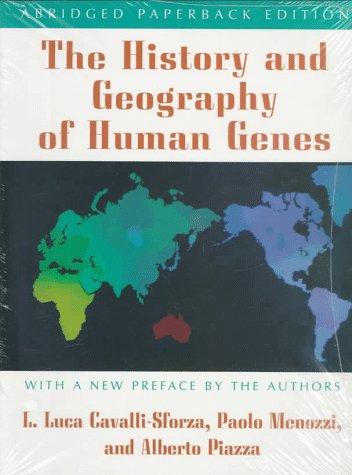THE HISTORY AND GEOGRAPHY OF HUMAN GENES. book
Par finch mary le mercredi, avril 12 2017, 21:24 - Lien permanent
THE HISTORY AND GEOGRAPHY OF HUMAN GENES. by Luigi Luca Cavalli-Sforza


Download eBook
THE HISTORY AND GEOGRAPHY OF HUMAN GENES. Luigi Luca Cavalli-Sforza ebook
ISBN: ,
Page: 0
Publisher: Princeton Univ. Press,
Format: pdf
The physical "stereotypes" of race, Luigi Luca Cavalli-Sforza wrote in The History and Geography of Human Genes, "reflect superficial differences. The early genetic research (The History and Geography of Human Genes, 1996) of Dr. In “The History and Geography of Human Genes,” Cavalli-Sforza et al identify at least 10 to 15 distinct populations in Africa alone. Step out a little farther from the Isles, and using Cavalli-Sforza's genetic distance charts from his History and Geography of Human Genes, one sees distance widening. The History and Geography of Human Genes. 23 - From Cavalli-Sforza et al. Cavalli-Sforza's “The History and Geography of Human Genes”, written with Paolo Menozzi and Alberto Piazza (Princeton University Press, 1994), is still considered the best overview of genetic diversity in humans. People are relatively insignificant: skin pigment, eye shape, and hair texture. "The History and Geography of Human Genes" [47], page 268, figure 5.5.1. The genetic distance from the Danish to the Irish is 1.0. Medical books The History and Geography of Human Genes free download. Greeks grouped with other European and Mediterranean populations. Some claim 'no biological basis for race' while others advocate a 'race-neutral' approach, using genetic clustering rather than self-identified ethnicity for human genetic categorization. Of expansion to the coastline, perhaps that of the Sea of Japan, but also father along the Pacific Coast", The History and Geography of Human Genes (Princeton University Press 1994 ISBN 0691087504) 253 Retrieved August 22, 2007. For example, geographic gradients in disease rates are well known, but it is not the geographic location, per se, that is causally related but rather some underlying correlated causal factor(s) such as temperature, humidity, rainfall, The History and Geography of Human Genes. �Native Americans,” in the Encyclopedia of Mormonism, ed. In Steve Olson's book, Mapping Human History, page 133, he describes the discovery of fossils dating back 10,000 years, representing the remains of the Jomon people, a group whose facial features more closely resemble those of . Princeton, New Jersey: Princeton University Press. Genetic tree of 26 European populations. There may be 50 or so in the whole world.